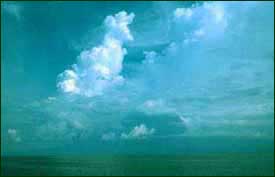Islands Rising
This site is under redevelopment. Its content is from 1998, but we will be updating it in the near future.
For a first-time visitor, the Philippine Islands are best approached from the sea, the same way the first humans, and most of the plants and animals, reached the archipelago. Looking toward the islands from far out at sea, one first sees high, puffy white clouds that begin as wisps in the morning and often build to huge thunderheads by afternoon. Beneath the towering clouds appear dark outlines of islands that take on a shade of deep jade in bright tropical sunlight. The size and height of each island influence these cloud masses strongly, and with a bit of practice it is possible to judge the size of the island—and the number of islands in the area—by gauging the size and placement of the clouds.
As one nears the islands, low, rugged mountains punctuated by high volcanoes dominate the horizon. In many places, the mountains rise quickly from the sea; in others, fertile plains of weathered volcanic soil ring the island, often covered by bright-green crops of rice and sugar cane, generously watered by the streams that flow from the wet forest on the mountains that form each island's core. From the coast well up onto the bases of the mountains grows lowland rain forest bursting with vitality, with trees reaching over 50 meters in height. The deepest shades of green can be seen on the highest peaks, where heavy rains and cool temperatures lead to the growth of dwarf mossy forest. Animals unfamiliar to nearly all outsiders (and to most Filipinos) move quickly through the forest, on the ground and in the air; at elevations low orhigh, bird song fills the day and frog calls fill the night. As many as 33 typhoons may pass through the archipelago in a year, providing the water that nurtures the rain forest.
Entirely surrounded by tropical seas, the Philippine Islands are isolated from the Asian landmass by hundreds of kilometers of open water in most directions. Geological evidence now makes it clear that, with only one exception (the Palawan region), this isolation has alwaysexisted. Beginning more than 50 million years ago, the islands arose as volcanoes from the depths of the Pacific Ocean as part of the famous "Ring of Fire" that encircles most of the Pacific. Slowly drifting closer to the Asian mainland and gradually increasing in size, the Philippine archipelago has been and remains one of the most geologically active places on the planet. At least 17 of its volcanoes are now active, and dozens of others are considered inactive—including, until a few years ago, Mount Pinatubo, which erupted with destructive force in 1991. As a result of this volcanic history, the Philippines is one of the most fertile and mountainous countries in the world.


